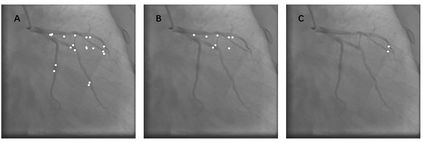Automatic identification of proper image frames at the end-diastolic (ED) and end-systolic (ES) frames during the review of invasive coronary angiograms (ICA) is important to assess blood flow during a cardiac cycle, reconstruct the 3D arterial anatomy from bi-planar views, and generate the complementary fusion map with myocardial images. The current identification method primarily relies on visual interpretation, making it not only time-consuming but also less reproducible. In this paper, we propose a new method to automatically identify angiographic image frames associated with the ED and ES cardiac phases by using the trajectories of key vessel points (i.e. landmarks). More specifically, a detection algorithm is first used to detect the key points of coronary arteries, and then an optical flow method is employed to track the trajectories of the selected key points. The ED and ES frames are identified based on all these trajectories. Our method was tested with 62 ICA videos from two separate medical centers (22 and 9 patients in sites 1 and 2, respectively). Comparing consensus interpretations by two human expert readers, excellent agreement was achieved by the proposed algorithm: the agreement rates within a one-frame range were 92.99% and 92.73% for the automatic identification of the ED and ES image frames, respectively. In conclusion, the proposed automated method showed great potential for being an integral part of automated ICA image analysis.
翻译:在对侵入性冠心血管血管成像仪(ICA)进行审查期间,自动确定端心外科(ED)和端心外科(ES)框架的适当图像框架非常重要,有助于评估心脏循环期间的血液流动,从双平面视图中重建三维动脉解剖图,并生成与心肌图互补的组合图。目前的识别方法主要依靠视觉解释,不仅耗时,而且减少复制。在本文件中,我们建议采用新方法,利用关键容器点(即地标)的轨迹,自动识别与ED和ES心脏阶段相关的血管图像框架。更具体地说,检测算法首先用于检测心血管动脉动的关键点,然后用光学流法跟踪选定关键点的轨迹。ED和ES框架是根据所有这些拟议轨迹确定的。我们的方法由两个独立的医疗中心(22个和9个病人)的62个自动成像框测试了与ECD和ES心脏阶段相关的血管图象框架。在1号和2个站点(即地标点)中,分别使用一种检测算法的检测算算算算法,根据两个最佳的逻辑框架进行了一个完整的逻辑分析。










